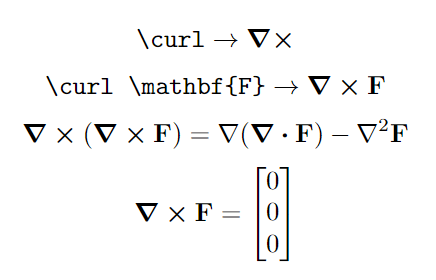Divergence (∇ ·) and Curl (∇ ×) operator in LaTeX
In this tutorial, I will show you how to write Divergence (∇ ·) and Curl (∇ ×) operator in a LaTeX document.
Divergence operator (∇ ·) in LaTeX
Usually, the Divergence operator is denoted by a \nabla (∇) and \cdot (·) symbol. You can use the \mathbf{} command (Use to bold any letter) for vector bold.
\documentclass{article}
\begin{document}
$$ \verb|\nabla \cdot \mathbf{F}| \rightarrow \nabla \cdot \mathbf{F} $$
$$ \mathbf{F} =\nabla \cdot \mathbf{F} =\left({\frac {\partial }{\partial x}},{\frac {\partial}{\partial y}},{\frac {\partial}{\partial z}}\right)\cdot (F_{x},F_{y},F_{z}) = {\frac {\partial F_{x}}{\partial x}}+{\frac {\partial F_{y}}{\partial y}}+{\frac {\partial F_{z}}{\partial z}} $$
\end{document}Output:

Divergence operator (∇ ·) with physics package
With the physics package, you can get the best output of the Divergence operator. The physics package provides a \div command to get this ∇ · output.
\documentclass{article}
\usepackage{physics}
\begin{document}
$$ \verb|\div| \rightarrow \div $$
$$ \verb|\div \mathbf{F}| \rightarrow \div \mathbf{F} $$
$$ \mathbf{F} =\div \mathbf{F} =\left({\frac {\partial }{\partial x}},{\frac {\partial}{\partial y}},{\frac {\partial}{\partial z}}\right)\cdot (F_{x},F_{y},F_{z}) = {\frac {\partial F_{x}}{\partial x}}+{\frac {\partial F_{y}}{\partial y}}+{\frac {\partial F_{z}}{\partial z}} $$
\end{document}Output:

Curl operator (∇ ×) in LaTeX
The Curl operator is denoted by a \nabla (∇) and \times (×) symbol. Uns use \mathbf{} command to get vector bold.
\documentclass{article}
\begin{document}
$$ \verb|\nabla \times \mathbf{F}| \rightarrow \nabla \times \mathbf{F} $$
$$ \nabla \times (\mathbf{\nabla \times F} )=\mathbf {\nabla } (\mathbf {\nabla \cdot F} )- \nabla^{2}\mathbf {F} $$
\end{document}Output:

Curl operator (∇ ×) with physics package
The physics package also provides a \curl command to get this ∇ × (Curl operator) output in a better way.
\documentclass{article}
\usepackage{physics}
\begin{document}
$$ \verb|\curl| \rightarrow \curl $$
$$ \verb|\curl \mathbf{F}| \rightarrow \curl \mathbf{F} $$
$$ \curl (\mathbf{\curl F} )=\mathbf {\nabla } (\mathbf {\div F} )- \nabla^{2}\mathbf {F} $$
$$ \curl \mathbf{F} = \begin{bmatrix} 0 \\ 0 \\ 0 \end{bmatrix} $$
\end{document}Output:

Leave a Reply